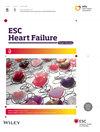Immuno-haemostatic dysregulation in heart failure with preserved ejection fraction
Abstract
Aims
Heart failure with preserved ejection fraction (HFpEF) is a complex condition with partially unclear pathophysiology, in which systemic inflammation is a central contributor to changes in cardiac structure and function. The contribution of non-traditional immune effectors—such as platelets and coagulation—remains underexplored in HFpEF. We characterized platelet function, as well as coagulation and neutrophil activation, in patients with HFpEF.
Methods
The in vivo activation of platelets, neutrophils, endothelial cells and coagulation was measured in plasma from patients with HFpEF (n = 103), age- and sex-matched controls (n = 40) and pooled plasma from a healthy reference cohort. Flow cytometric and microfluidic assays were performed to investigate platelet function ex vivo.
Results
Compared with matched controls, patients with HFpEF exhibited reduced platelet reactivity, characterized by alterations in platelet integrin activation and granule release, and an overall decrease in thrombus activation, contraction and fibrin formation. In vivo platelet activation markers β-TG and CXCL4 were increased in plasma from patients with HFpEF and matched controls compared with the healthy reference cohort (β-TG: 923.01 and 822.25 vs. 335.06 ng/mL; CXCL4: 660.16 and 603.63 vs. 458.34 ng/mL). Linear regression analyses showed an association between platelet aberrant activation and function and the presence of HFpEF, independent of comorbidities or medications [e.g., thrombus characteristics (size, contraction, height): P valuesFully adjusted model = <0.001; <0.001; <0.001]. Patients with HFpEF showed higher levels of the neutrophil activation markers MPO and S100A8/A9 compared with matched controls (MPO: P value = 0.0152; S100A8/A9: P value = 0.0041). Levels of endothelial markers ICAM-1 and VCAM-1 were unaltered between groups. Coagulation was found elevated in patients with HFpEF, particularly in patients not on anticoagulant (AC) medications, showing increased plasma levels of plasma kallikrein, factor XI, factor IX, thrombin and D-dimer (kallikrein: P value = 0.0415; AC excluded: FXIa:C1inh: P value = 0.0110; FIXa:AT: P value = 0.0095; T:AT: 4.46 vs. reference 4 μg/L; D-dimer: 0.65 vs. reference 0.5 mg/L).
Conclusions
Patients with HFpEF present with dysfunctional platelets, a procoagulant state and neutrophil activation. The association of immuno-haemostatic processes including aberrant platelet function with the presence of HFpEF, independent of comorbidities or medications, suggests that platelet dysfunction is an intrinsic feature of HFpEF.


 求助内容:
求助内容: 应助结果提醒方式:
应助结果提醒方式:


